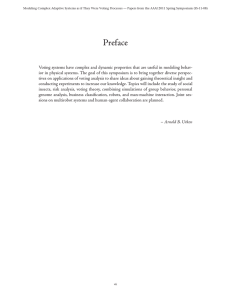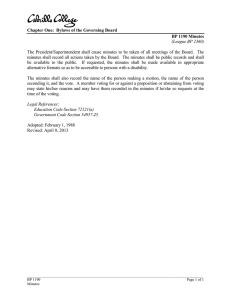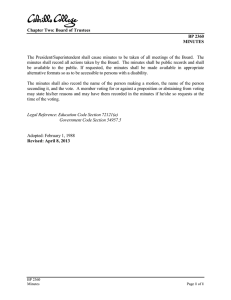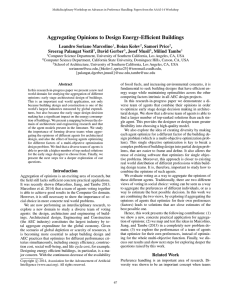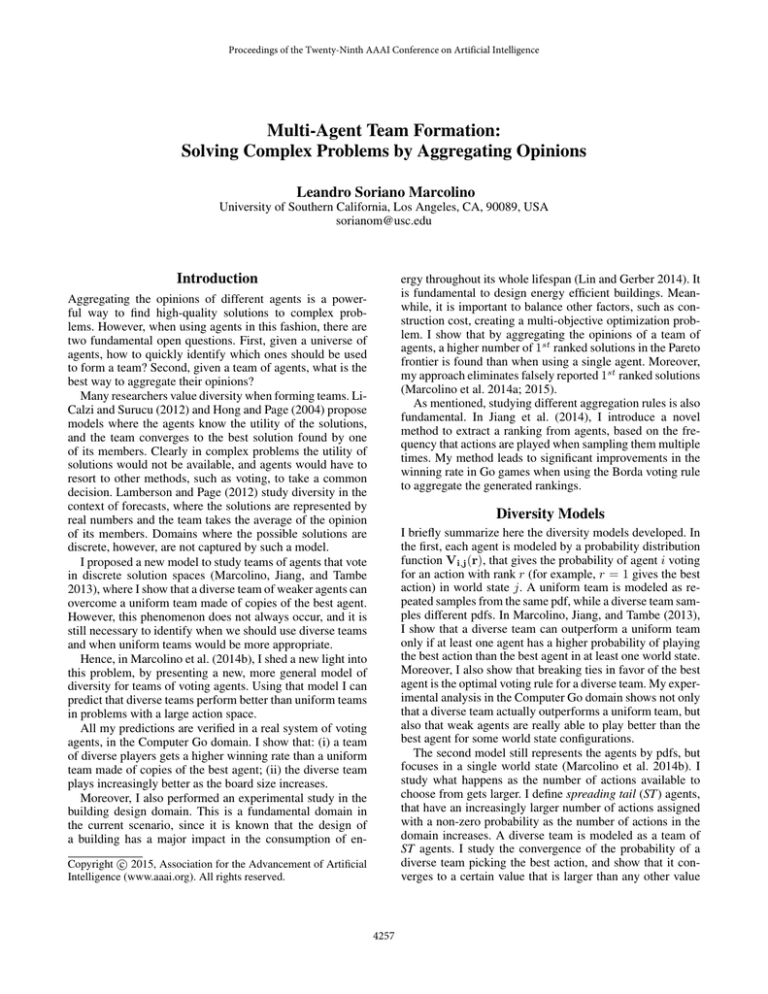
Proceedings of the Twenty-Ninth AAAI Conference on Artificial Intelligence
Multi-Agent Team Formation:
Solving Complex Problems by Aggregating Opinions
Leandro Soriano Marcolino
University of Southern California, Los Angeles, CA, 90089, USA
sorianom@usc.edu
Introduction
ergy throughout its whole lifespan (Lin and Gerber 2014). It
is fundamental to design energy efficient buildings. Meanwhile, it is important to balance other factors, such as construction cost, creating a multi-objective optimization problem. I show that by aggregating the opinions of a team of
agents, a higher number of 1st ranked solutions in the Pareto
frontier is found than when using a single agent. Moreover,
my approach eliminates falsely reported 1st ranked solutions
(Marcolino et al. 2014a; 2015).
As mentioned, studying different aggregation rules is also
fundamental. In Jiang et al. (2014), I introduce a novel
method to extract a ranking from agents, based on the frequency that actions are played when sampling them multiple
times. My method leads to significant improvements in the
winning rate in Go games when using the Borda voting rule
to aggregate the generated rankings.
Aggregating the opinions of different agents is a powerful way to find high-quality solutions to complex problems. However, when using agents in this fashion, there are
two fundamental open questions. First, given a universe of
agents, how to quickly identify which ones should be used
to form a team? Second, given a team of agents, what is the
best way to aggregate their opinions?
Many researchers value diversity when forming teams. LiCalzi and Surucu (2012) and Hong and Page (2004) propose
models where the agents know the utility of the solutions,
and the team converges to the best solution found by one
of its members. Clearly in complex problems the utility of
solutions would not be available, and agents would have to
resort to other methods, such as voting, to take a common
decision. Lamberson and Page (2012) study diversity in the
context of forecasts, where the solutions are represented by
real numbers and the team takes the average of the opinion
of its members. Domains where the possible solutions are
discrete, however, are not captured by such a model.
I proposed a new model to study teams of agents that vote
in discrete solution spaces (Marcolino, Jiang, and Tambe
2013), where I show that a diverse team of weaker agents can
overcome a uniform team made of copies of the best agent.
However, this phenomenon does not always occur, and it is
still necessary to identify when we should use diverse teams
and when uniform teams would be more appropriate.
Hence, in Marcolino et al. (2014b), I shed a new light into
this problem, by presenting a new, more general model of
diversity for teams of voting agents. Using that model I can
predict that diverse teams perform better than uniform teams
in problems with a large action space.
All my predictions are verified in a real system of voting
agents, in the Computer Go domain. I show that: (i) a team
of diverse players gets a higher winning rate than a uniform
team made of copies of the best agent; (ii) the diverse team
plays increasingly better as the board size increases.
Moreover, I also performed an experimental study in the
building design domain. This is a fundamental domain in
the current scenario, since it is known that the design of
a building has a major impact in the consumption of en-
Diversity Models
I briefly summarize here the diversity models developed. In
the first, each agent is modeled by a probability distribution
function Vi,j (r), that gives the probability of agent i voting
for an action with rank r (for example, r = 1 gives the best
action) in world state j. A uniform team is modeled as repeated samples from the same pdf, while a diverse team samples different pdfs. In Marcolino, Jiang, and Tambe (2013),
I show that a diverse team can outperform a uniform team
only if at least one agent has a higher probability of playing
the best action than the best agent in at least one world state.
Moreover, I also show that breaking ties in favor of the best
agent is the optimal voting rule for a diverse team. My experimental analysis in the Computer Go domain shows not only
that a diverse team actually outperforms a uniform team, but
also that weak agents are really able to play better than the
best agent for some world state configurations.
The second model still represents the agents by pdfs, but
focuses in a single world state (Marcolino et al. 2014b). I
study what happens as the number of actions available to
choose from gets larger. I define spreading tail (ST) agents,
that have an increasingly larger number of actions assigned
with a non-zero probability as the number of actions in the
domain increases. A diverse team is modeled as a team of
ST agents. I study the convergence of the probability of a
diverse team picking the best action, and show that it converges to a certain value that is larger than any other value
c 2015, Association for the Advancement of Artificial
Copyright Intelligence (www.aaai.org). All rights reserved.
4257
obtained in lower action space sizes. Moreover, I show that
if the action space is large enough, the probability of a diverse team choosing the best action converges to 1 as the
number of agents increases.
As we can see, the teams clearly outperform the individual
agents, and provide a higher number of 1st ranked solutions.
Next Steps
Many research directions are still open, and I will keep developing further. I plan to defend my thesis in May 2016, so
there is still a significant amount of research to be developed.
Moving forward, I expect to perform a theoretical study
of diverse teams in multi-objective optimization problems,
in order to better understand the results in the building design domain. I also expect to develop new techniques for
the aggregation of opinions, in order to be able to eventually
overcome the performance of the best parallelization algorithm available for Computer Go. It is also possible to use
machine learning in order to categorize different kinds of
world states (such as positions of the Go board), and based
on that information dynamically change the team and/or the
voting rule. Hence, many different approaches can still be
developed and studied in order to unleash the potential of
diverse teams and aggregation of opinions.
Finally, I also recently observed that it is possible to use
the voting patterns to predict the final performance of teams
of voting agents. Such “side-effect” of voting has not been
observed before, and it allows an operator to take remedy
procedures if the performance of a team presents issues. I
am currently performing a deeper study of this phenomenon.
Acknowledgments: This research was supported by
MURI grant W911NF-11-1-0332.
Experimental Results
Winning Rate
I summarize here some
of the main experi0.75
mental results obtained
0.70
so far, in the Computer Go domain and in
0.65
the building design domain. In Figure 1, we
0.60
Diverse
Uniform
see one of the results in
0.55
8 10 12 14 16 18 20 22
Computer Go. We can
Board Size
see the winning rates
of a diverse (composed
Figure 1: Winning rate in the
by the Computer Go
real Computer Go system, as
playing agents Fuego,
the board size grows.
Gnugo, Pachi, Mogo)
and a uniform team. As
we can see, the diverse team starts by playing slightly worse,
but plays better than the uniform team with statistical significance in large boards.
0.6
Winning Rate
0.5
0.4
0.3
References
0.2
Hong, L., and Page, S. E. 2004. Groups of diverse problem solvers can outperform groups of high-ability problem
solvers. Proc. of the National Academy of Sciences of the
USA 101(46):16385–16389.
Jiang, A. X.; Marcolino, L. S.; Procaccia, A. D.; Sandholm,
T.; Shah, N.; and Tambe, M. 2014. Diverse randomized
agents vote to win. In NIPS.
Lamberson, P. J., and Page, S. E. 2012. Optimal forecasting
groups. Management Science 58(4):805–810.
LiCalzi, M., and Surucu, O. 2012. The power of diversity over large solution spaces. Management Science
58(7):1408–1421.
Lin, S.-H. E., and Gerber, D. J. 2014. Evolutionary energy performance feedback for design. Energy and Buildings 84:426–441.
Marcolino, L. S.; Kolev, B.; Price, S.; Veetil, S. P.; Gerber,
D.; Musil, J.; and Tambe, M. 2014a. Aggregating opinions
to design energy-efficient buildings. In M-PREF 2014.
Marcolino, L. S.; Xu, H.; Jiang, A. X.; Tambe, M.; and
Bowring, E. 2014b. Give a hard problem to a diverse team:
Exploring large action spaces. In AAAI.
Marcolino, L. S.; Gerber, D.; Kolev, B.; Price, S.; Pantazis,
E.; Tian, Y.; and Tambe, M. 2015. So many options, but we
need them all: Agent teams for design problems. In AAMAS.
(submitted).
Marcolino, L. S.; Jiang, A. X.; and Tambe, M. 2013. Multiagent team formation: Diversity beats strength? In IJCAI.
0.1
0.0
Plurality
Plurality
Non-sampled Sampled
Borda
Harmonic
Maximin
Copeland
Figure 2: All voting rules, for diverse with 5 agents, using
the new ranking methodology.
Number of 1st ranked solutions
In Figure 2, I show one result from my novel ranking
methodology. In these results, a ranking is built by sampling
each agent 10 times. We can see that all voting rules outperform plurality; Borda and maximin are statistically significantly better (p < 0.007 and p = 0.06, respectively). All
ranked voting rules are also statistically significantly better
than the non-sampled (single run) version of plurality.
Finally, in Figure 3 I show
Agent 1
one of the reAgent 2
70
Agent 3
sults in the build60
Agent 4
Uniform - Vote
50
ing design doUniform - Mean
Uniform - Median
40
main. The figure
Diverse - Vote
30
Diverse - Mean
shows the numDiverse - Median
20
st
ber of unique 1
10
ranked solutions
0
Agents
Diverse
Uniform
found by individual agents and by
Figure 3: Number of unique 1st
different teams,
ranked solutions, for each agent and
for one building
the teams.
design problem.
4258

